"Lynx" in the service of the Bundeswehr. SpPz 2 Luchs combat reconnaissance vehicle
When you first look at the SpPz 2 Luchs in your head there is an association with domestic BTR. The machine has the same wheel formula, recognizable silhouette of the hull, as well as a similar location of the side exit hatch between the second and third axles in the very middle of the hull. The presence of a cannon tower makes the “Lynx” similar to the latest Russian BTR-80A or BTR-82 models. In total, during the serial production from 1975 to 1978, the 408 BRM "Lynx" was assembled in Germany. The last surviving copies of the SpPz 2 Luchs were decommissioned in the 2009 year, replaced by Fennek light armored vehicles in the German army.
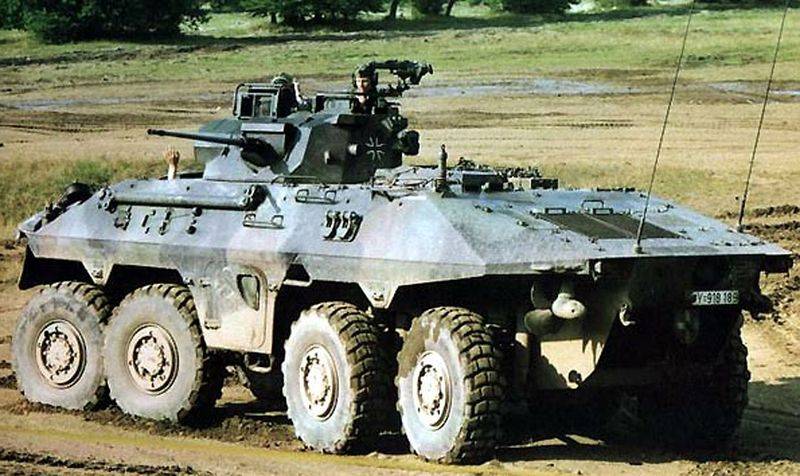
SpPz 2 Luchs: from idea to implementation
The need to develop a new efficient reconnaissance vehicle was recognized by the German military at the beginning of the 1960s. According to the Bundeswehr officers, the new combat reconnaissance vehicle was to receive two command posts (dual control). Previously, such combat vehicles have already been created in different countries. Back in the years of the First World War, the White AMD armored vehicle was created in France, which had two control posts. Before the start of World War II, the French designers presented another very successful combat vehicle with the same layout - the famous Panhard 178 cannon armored car, also known as AMD 35. The driver’s second driver’s position was also on the Swedish light armored car Landsverk-185, which was most similar to the FAI-M Soviet light armored car. So the idea with two control posts and two drivers was not revolutionary, it was actively used in some countries, especially in neighboring France, where armored vehicles with such a layout appeared after the end of World War II.
The chosen layout, as envisioned by the German military, provided the future combat reconnaissance vehicle (BRM) with the highest possible level of maneuverability and the ability to quickly get out of the shelling, starting backward at the same speed. Also, the new BRM should have a high speed and good traffic, including in inaccessible areas. On this basis, the German military initially insisted on a combat vehicle created on the basis of a four-axle chassis with a wheel formula 8х8.
The largest machine-building companies of Germany were attracted to the development of a new combat reconnaissance vehicle. The order was accepted and launched by a consortium of enterprises, which included Henschel and Krupp, as well as Daimler-Benz. The prototypes of the future BRM were prepared by both contestants already in 1968 year. Initially, the armored vehicle was tested on the basis of the Trier-Grünberg Army Center of the Bundeswehr, after which the program was greatly expanded and complicated. Prototypes visited different climatic zones, having passed the way of tests in snowy Norway and hot Italy, where armored vehicles were tested in mountainous conditions. Fully tested only in 1972 year. Prototypes of the new combat reconnaissance vehicle had, by that time, reeled up 200 thousands of kilometers on the odometer.
In total, in the process of testing, competing companies manufactured 9 armored cars, in the design of which various additions and changes were made. Much attention was paid to changing the transmission and the choice of the power plant. After analyzing the test results, preference was given to the sample, which was designed by order of the company Daimler-Benz. It was this company that was entrusted with the process of finalizing and sending the intelligence machine to mass production. Novelty received the designation Spähpanzer 2 (SpPz 2) Luchs. The order for the release of the BRM lot from 408 units was received in December 1973, the first production vehicles were ready in May 1975, and in September of the same year they began to enter into service of the reconnaissance battalions of the Bundeswehr divisions.
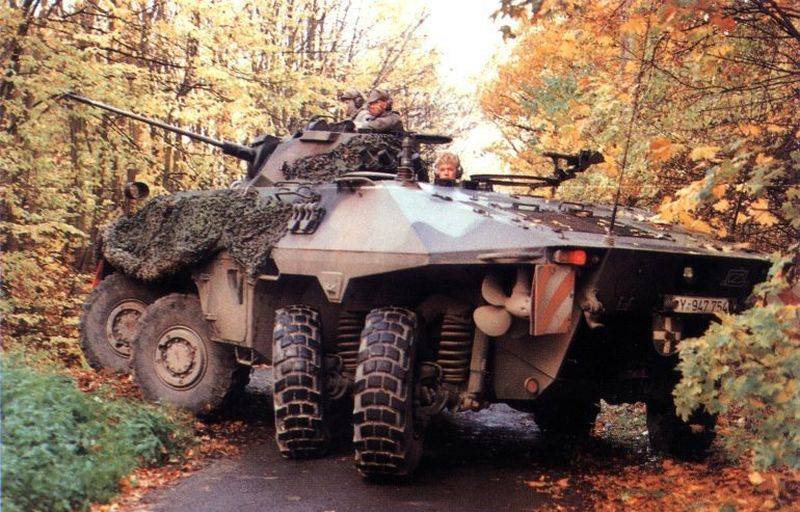
BRM Luchs layout
Externally, the new German armored car was an eight-wheel lightly armored vehicle, the crew of which consisted of four people. All the wheels of the reconnaissance vehicle were controllable, which ensured a turning radius of 7 meters for a car longer than 5,73 meters. When driving at high speed, for example, moving on a highway, control of medium pairs of wheels was simply turned off. A prominent feature of the BRM and its design feature was the presence of two control posts spaced apart in the front and aft of the hull. The “Lynx” was equally agile when moving back and forth. At the same time, the driver-mechanic, who was located in the aft post, also served as a radio operator; in addition to standard controls, a navigation system equipment and a radio station were installed at his workplace. It is worth noting that this crew member is only involved in the management of the armored vehicle in emergency situations. The maximum speed of movement both forward and back was 90 km / h. The order to change the direction of the combat reconnaissance vehicle was given by its commander.
The presence of two control posts made the designers turn to the layout layout unusual for most models of modern armored vehicles, in which the power plant was placed in the central part of the combat vehicle. At the same time, the workplace of the main mechanic-driver was preserved in front of the BRM Luchs. The location of the main mechanic drive turned out to be three devices for monitoring the road and terrain, one of which could be replaced with a night vision device. The driver got into his workplace through a hatch in front of the hull, his lid does not fold back, but turns to open to the right.
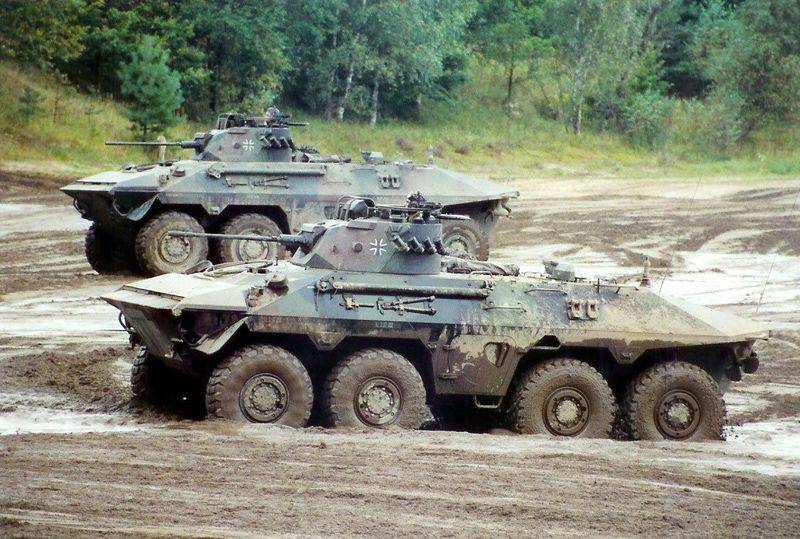
In addition to the front driver and rear mechanic-radio operator, the crew of the Lynx also includes a commander and a gunner, whose workplaces are located in the fighting compartment, above which a TS-360 tower rotating at 7 degrees is installed. The gunner's place is on the right, the commander is on the left. The tower was installed a little closer to the front of the combat vehicle to reduce the “dead zone” in front of the BRM. The main weapon located in the rotating turret was the 20-mm Rheinmetall Rh-202 automatic cannon (375 rounds of ammunition), which could be used with armor-piercing, armor-piercing tracer and high-explosive ordnance. The gun's rate of fire was 800-1000 shots per minute, the effective firing range - up to 2000 meters. On top of the turret, directly above the hatch of the commander of the vehicle, was placed an 7,62-mm MG-3 machine gun (1000 rounds of ammunition). The corners of the vertical guidance of the automatic cannon were impressive - from -15 to + 69 degrees, this allowed the use of the gun for firing at air targets. The corners of the vertical guidance of the machine gun were slightly more modest - from -15 to + 55 degrees. On both sides of the turret were blocks of smoke grenade launchers (4 grenade launcher from the left and right side of the turret).
Technical features of the Luchs combat reconnaissance vehicle
Since the car was a reconnaissance vehicle, it received quite a complex, one might say unique equipment for the 1970-s. At the disposal of the second mechanic, there was an onboard system of navigation equipment FNA-4-15. The constructors placed the sensor of the path and the gyro cursor system onboard the combat vehicle, they were connected with the BRM transmission. The incoming data were processed using an onboard computer and displayed on liquid crystal screens, allowing the crew to always know the coordinates and course of the vehicle. Naturally, during the operation the BRM were repeatedly upgraded, in particular, were equipped with GPS receivers.
The heart of the Lynx reconnaissance was the multi-fuel V-shaped 10-cylinder engine OM 403 VA, which equally well digested both diesel and gasoline. Developed by the designers of Daimler-Benz, the engine received a turbocharger and could develop the maximum power of the 390 HP. (when working on diesel fuel). The engine was part of a single power unit with an automatic four-speed gearbox ZF 4 PW 96 H1. Also in the power compartment there was a place for an automatic fire extinguishing system. The engine power was enough to accelerate the armored vehicle with a combat mass of almost 19,5 tons up to the speed of 90 km / h when driving on the highway. Cruising when driving on roads was estimated at 800 kilometers.
The designers of the Lynx combat reconnaissance vehicle paid great attention to the issue of its stealth on the battlefield. The engine compartment was insulated with special gas-tight bulkheads, and the engine received not only an exhaust silencing system, but also air intake silencers. This solution made it possible to seriously reduce the noise of the machine, SpPz 2 Luchs was not easy to hear, even from a distance of just 50 meters. In addition, the designers brought the exhaust pipe into the aft compartment of the machine, where a strong fan worked, which mixed the exhaust gases with clean inboard air. Such a solution made it possible to greatly reduce the temperature of exhaust gases, reducing the visibility of the reconnaissance vehicle for enemy thermal imagers.
Another feature of the SpPz 2 Luchs reconnaissance vehicle was the ability to swim. For a combat vehicle with such a role on the battlefield, this was a useful option. But in general, for Western armored vehicles, the ability to independently navigate through water barriers was a rare feature. The maximum travel speed afloat was 10 km / h. Afloat the car moved with the help of two propellers, which were hidden in the feeding niches. For the possibility of pumping outboard water, which could get inside the hull, the crew had three bilge pumps that could pump up to 460 liters of water per minute. Later in the process of upgrading the combat vehicle, installing new equipment and additional reservations, which resulted in an increase in combat mass, the possibility of self-buoyancy was lost.
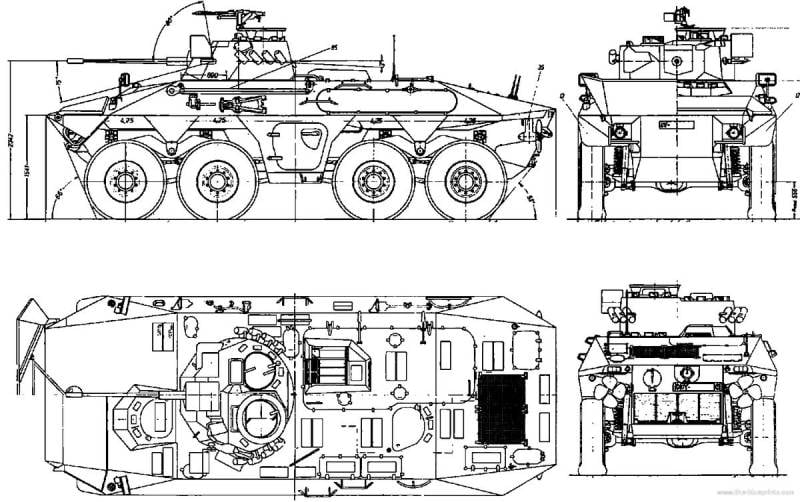
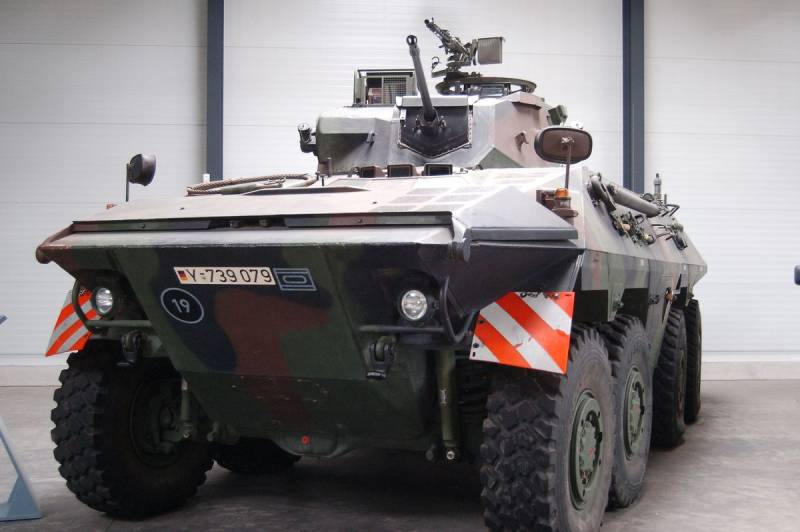
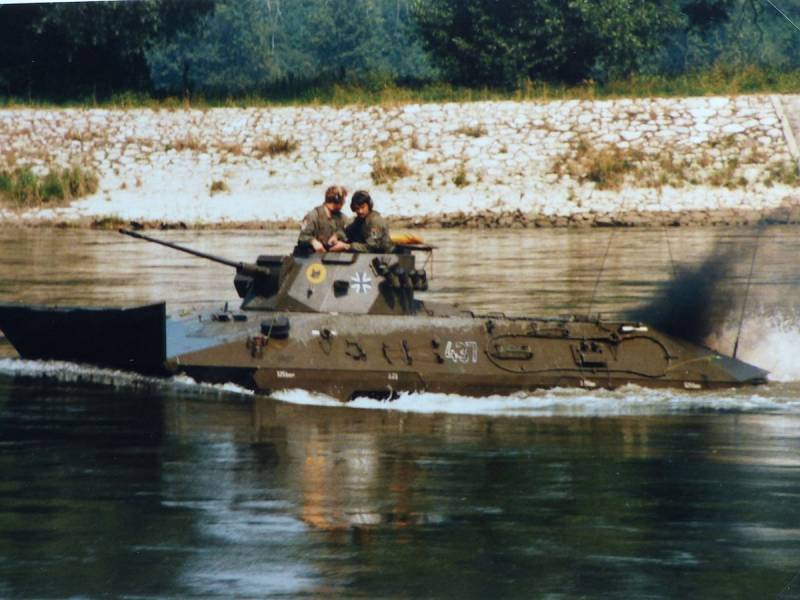
Information